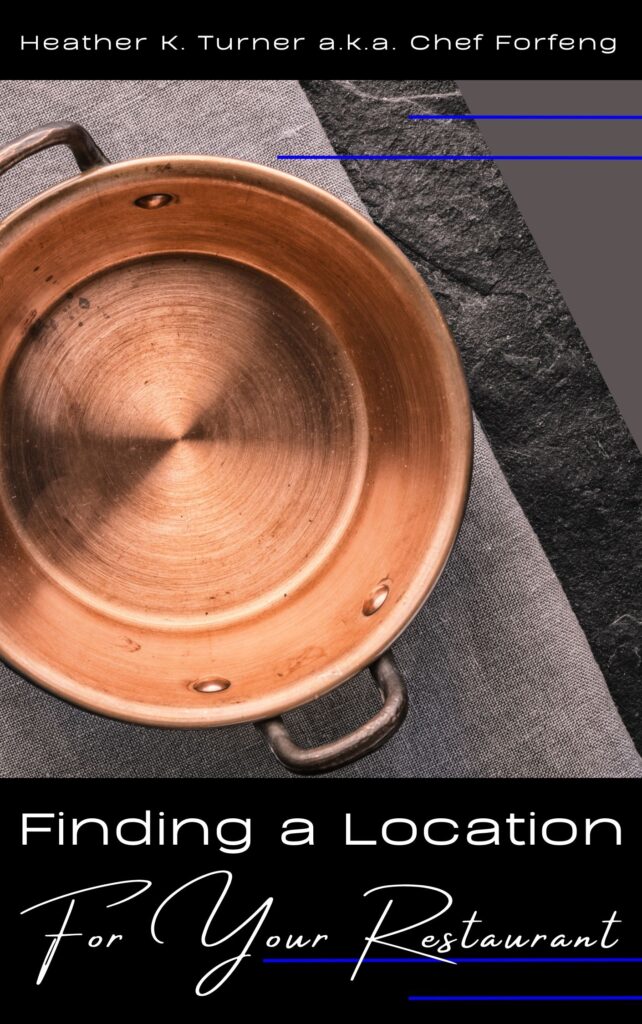by Heather T. | Jan 1, 2025 | Bed and Breakfasts, Business, Food, Lodging, Marketing, Observations, Operations, restaurants
With the new year and possibly some additional challenges to the hospitality industry coming ahead, restaurants and lodging may want to think about some additional alterative ways to generate income.
I look at it this way: Plan for the Best but be Prepared for the Worst. If you are a Monty Python fan, you might recognize “No one plans for the Spanish Inquisition”. If you are not, do a little search on YouTube for the full sketch.
Many businesses don’t expect hurricanes, tornadoes, floods, earthquakes or other disasters both natural and man-made, no one could have predicted the impact Covid had, no matter what side of the fence you sit on, it had a significant impact on the economy.
Something along those lines or other (aliens could take over the world, we really don’t know what’s out there in the universe, or there could be a solar flare, sadly even more realistic) could happen but the reality is, businesses should prepare, just in case. Again, Plan for the Best but be Prepared for the Worst (as a backup plan).
I advise businesses it doesn’t matter how well your business is doing. Never stop marketing and always be prepared. When you have a power outage for a couple of days, better to have a couple of gallons of water on hand than not. Think of this as having some extra water kicking around (just as a backup) and extra money in your pocket is never a bad thing to have.
For Lodging:
Staycations have been “in” for a while, but how many lodging establishments have actually created packages for them or created a marketing plan for them?
For Rooms: (If you have 6 rooms or more (or even less) but bookings are low:
- If you have extra rooms not regularly booked, consider offering them for monthly, quarterly, or longer-term rentals. Dedicated income is never a bad thing. Medical professionals, visiting doctors and nurses are having an ongoing time finding housing and they are great short term and longer term tenants.
- Office space or Co-working space. Massage therapists always seem to be looking for space rental (also something you can use in your advertising: massage therapist on site). I saw two “asks” in local Facebook forums just in the last couple of days.
- Inventory storage space for another local business and/or climate controlled storage space for rent.
- Studio space for artists (you could tie packages into an artist in residence).
- Counselors or therapist’s rental space.
- Nonprofit office space.
For Your Dining Room/Living Room/Other Space
- Rent out space as needed to photographers/videographers who may need space for photo/video shoots.
- Offer the space for local meetings or events. If the layout and setup is conducive to having a screen and projector setup available for meetings, consider buying a projector and screen. For under $300 you can purchase both for the needs of a smaller room, and if you rent them out to meetings even for $50 or less, you can quickly make your money back. Renting out a projector from a party planning business typically costs twice that. I’d recommend if you go this route and start doing a lot of meetings adding a backup projector to the mix. You can get refurbished older projectors affordably from Ebay and Amazon. Upsell it by offering coffee, tea and other refreshments or box lunches.
- Pop up shops for local crafters or indoor farmers’ market
- Consider the old style boarding house model, room and board for monthly or longer-term renters. Finding housing is at an all time need around the country and there are probably professionals who don’t have the time or desire to cook meals for themselves, plus in need of housing. Check your local zoning laws and state laws, but if your property is already a commercial business, this may just be getting another license for an additional type of food permit. In New Hampshire, a Bed and Breakfast license is $175 per year, a restaurant license for 25-99 seats is $350 a year. You may need some additional inspections or requirements but it might be worth looking into. If you have six rooms and rent two long-term or monthly at $50 a night, that generates about $1500 a month per room, or $36,000 a year for two. Is it worth it to you to cook an extra couple of meals per day and do some extra cleaning? Even with food and some extra time for laundry, something to chew on. Just like renting to a longer term renter, you would want to be selective of who you take in, but probably less trouble than some short-term rental guests who come from an online platform.
- During the day when the space is not being used, rent it out for yoga or mediation classes (again this could be a good advertising addon for your own business)
For Both Lodging and Restaurants:
- Rent out the kitchen for commissary kitchen space (when you are not using it). There are a lot of small food producers who are looking for commercial kitchen space to use. Connect with your local SCORE chapter, SBDC, or CWE offices and let them know, so they can let clients know you have space available. In New Hampshire for example, there are less than 5 commissary kitchen spaces for use by food producers, food trucks, small chef and catering companies and other food base companies like people who make dog biscuits, but have too much volume for a home kitchen. Cottage food laws may allow a dog biscuit business to bake at home in New Hampshire, but a personal chef making meal kits must use a commercially inspected commissary kitchen or other state inspected facility. In every state, there seems to be a lot less commissary kitchen space available than what the needs of small food businesses are looking for. I run into this frequently when working with food trucks and other small food independent food providers.
- Consider co-op buying with other local food type businesses. Many decades ago, when I was a chef on Cape Cod, we did this with some other local restaurants during the slow time of year. On Cape Cod in the busy seasons, we would do several hundred covers (dinners) per night on a weekend night, during the winter sometimes we would be lucky to do a dozen covers. The choice between shopping at a grocery store to keep the restaurant going was not an option because prices are higher than wholesale, so we banded together so we could make a broadliner’s (for those new or starting in the industry, a broadliner is a larger wholesale foodservice vendor) minimum order requirements which could be $400 per minimum order. B&Bs, hotels, bakeries, restaurants, cafes and caterers, as well as smaller food service businesses (like those mentioned above) could all take advantage of co-op buying to buy in bulk and keep costs down.
For restaurants:
For restaurants I wish I had a magic wand above and beyond renting out kitchen space for additional income to deal with high food costs and the ongoing employee shortage, but here are some ideas that you could try to bring in some extra revenue and try some things that are a little different to incentivize customers to patronize your establishment.
- This differs from just renting out kitchen space, more along the lines of renting out the full restaurant during any days you are not normally open. Consider the Restaurant-as-a-Service (RaaS) for other small businesses. Rent out your full facility out to chefs or starting entrepreneurs (suggested they have business insurance and ServSafe at a minimum) to test out limited time menus or food concepts. There is no lack of people who want to start a food truck and want to test out their menus in advance, or private chefs who may want to advertise their services more. You could use this as an additional marketing tool to create buzz for your business, and tie into additional cross promotions with any small business you might partner with.
- Offer Tasting Tuesdays (or any day of the week). Beer or Wine Tastings (on your closed days) with snacks or small plate meals. Coordinate with your beverage reps to help with promotions and products.
- Beer and wine flights have been a “thing” for awhile, but what about tea or coffee flights paired with desserts or other complimentary foods, like a tea flight paired with tea smoked fish and tea smoked vegetables and/or cheeses.
- Partner with food banks or pantries to donate excess or close to code food, reinforcing your community involvement. Helping your local community and being realistic here, it’s a good advertising hook, and if donating to a 501c3, a potential tax write off. You have 2 days left on 4 gallons of milk and business is slow and you will never use it all up in time…..
- Host cultural learning dining nights, a theme might be the food of India and have some education around the menu and the ingredients, history of the dishes, and more. A server can give an overview when guests are seated, and you can provide printed handouts or QR codes on menus or tabletop stands linking to more information about each dish, its ingredients, and preparation.
A few additional things I’ve seen getting traction in bigger urban areas and a few additional ideas as well.
Incentives for bring your own takeout containers to reduce your takeout container costs (plus it’s more eco friendly and good advertising hook.
Organize some interactive dining experiences, Dining in the Dark, for instance. Many years ago, my husband and I attended a benefit dinner where you ate a 4-course meal while blindfolded. The dinner benefited a New England Guide Dog organization; the organization covered all staff and food costs, and the restaurant kept income from drinks ordered before, during, and after the dinner. Prior to the dinner there was a cash bar and light hors d’oeuvres. The event was packed with a waiting list and I have to be honest, as an attendee, it was one of the most fun dinners I’ve ever had.
A few more:
Murder Mystery Dinners, Interactive Dessert Stations (if you have never seen anyone make ice cream with liquid nitrogen, it’s a blast to watch), escape room dining (diners have to solve puzzles to get access to drinks or courses), team building dinners, roll your own California/Nori rolls (with a demonstration and people to assist if needed). Themed dinners like time travel night (food from another era) or international cuisine night. Go whole hog and do a Star Trek themed night with foods that mimic foods found in Star Trek episodes (Gagh for example is made of serpent worms (in the show), it wouldn’t be hard to make pasta with a soy-based sauce that mimics the look (but not flavor 😊) of this traditional Klingon delicacy.) If you do a little search in Google or ChatGPT for food and drinks inspired by tv shows and movies, you came up with some fun ideas you could build whole themed nights around things like Pan Galactic Gargle Blaster (Hitchhiker’s Guide) – Gin, lemonade, and a touch of absinthe or licorice liqueur, Twin Peaks Cherry Pie – A classic diner-style cherry pie with a flaky crust and Red Rum Cake (The Shining) – A rich red velvet cake with dark chocolate icing and many more.
In the coming months, I’ll try to suggest some additional revenue streams and ideas for restaurants to experiment with as well.
Happy New Year!
A Toast to the Hospitality World filled with dedicated, hardworking people who love food and the industry. May the coming year be filled with happy customers and guests, good reviews, and fresh opportunities to make a profit.
by Heather T. | Feb 12, 2024 | Business, Food, Marketing, Observations, Operations, restaurants
 Recently there was an article on Eater. “Why not bring takeout containers to restaurants?” and I thought, wow this is such a great idea (not rocket science obviously) but I should start doing this. What a great way to save the environment and, by the way, save our favorite restaurants a few bucks in the bargain.
Recently there was an article on Eater. “Why not bring takeout containers to restaurants?” and I thought, wow this is such a great idea (not rocket science obviously) but I should start doing this. What a great way to save the environment and, by the way, save our favorite restaurants a few bucks in the bargain.
Which, of course, led to the inevitable 2 AM neurodivergent thought, OH!, how can a restaurant leverage this? There must be restaurants doing this already, and of course, there were and there are. Restaurants give discounts to diners who bring their own dishes (2019) and many more. One thing that I noticed though about the restaurants and other food service operations that offered this is there didn’t seem to be a ton of thought into “targeted” getting people back in the door. Some offered discounts off of a future meal, some off of a current meal, some free refills (for beverages) but not much real upselling.
From a customer funnel point of view, if you want to think about getting repeat customers back in the door, what’s the incentive to get them back in PLUS the incentive to spend more money?
I’d love to see a restaurant out there (and maybe there is, let me know!) who would offer the incentive “BYOC (Bring Your Own Container)” and get a voucher/coupon for a free coffee or tea and our signature dessert.
Why that? Coffee or tea doesn’t cost most to provide and if you created the incentive wisely a signature dessert could cost a few dollars or less to make. Tiramisu is cheap to make, so is a scoop of homemade (or a good prepared) mousse with some flavored whipped cream to zip it up. Dessert has a much higher profit margin on it typically than an entrée or appetizer.
If you just give them a discount or small incentive, it doesn’t do much for repeats, it can help, but what’s the upsell part of it?
If you get them to come in and get drinks, maybe an appetizer and a couple of entrees (make the must order an entrée as part of the small print on the coupon), it’s an incentive to get people in the door and spent money first.
Even if it’s a couple who come in regularly and they bring two takeout containers, give them two vouchers. If you look at it from the perspective of how is any different from giving them a $10 off coupon their next meal, it is different because your incentive is to give them something for free but they have to spend money first. Even without a couple ordering appetizers, if a couple’s tab is a couple of entrees (mid-priced restaurant average) 17.99 X 2, plus a couple of soft drinks (up the take if it’s beer or wine) 2.50 X 2, and the regular check average is $50.00 and you just “gave away” $3.50 in product, when it boils down to it that’s pretty inexpensive marketing. If your price points for your menu items are higher, the ratios are even better.
You actually get three birds with this: promoting eco-friendly practices, saving money on your own to go containers and getting people in the door for repeat dining. Even if you encourage regulars to give them to others, that’s not a bad thing, it increases brand awareness and you get the same result; you get more people in the door and they order the big-ticket items like entrees (and if your waitstaff is good at the in-person upsell, high profitably drinks).
If you are going to try any incentives like this, make sure they contribute to your bottom line.
I’ve seen too many restaurant coupons that just give a discount with no stipulations on use or no incentive to get people to buy more.
So if you create an initiative to bring in customers, track through what you get out of it. Is it a onetime sale, something that will get people to come in many times or something that will make people spend more money because of the incentive itself?
There were a couple of good articles I came across in searching for restaurants that did have to go container incentives that I think would be worth a read.
How can restaurants take advantage of sustainable packaging?
What Are Reusable Food Container Programs?
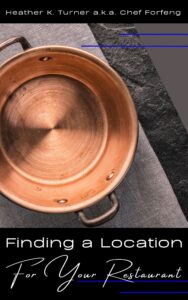
By the way, my first book just got released on Amazon this weekend in Paperback and on Kindle! Check it out! Finding a Location for your Restaurant: How to Scout the Perfect Location for your Dream of Opening a Restaurant or other Hospitality Business.
by Heather T. | Jan 9, 2024 | Food, Observations, Operations, restaurants
 I had a meeting with a client recently, and a big part of our conversation was about hiring for a restaurant.
I had a meeting with a client recently, and a big part of our conversation was about hiring for a restaurant.
I had to dig out my notes to send them but realized I don’t think I’ve ever put these questions out on the blog that I have used in the past as part of working in restaurants in management and for the last twenty years in consulting, where I’ve helped interview candidates for positions.
While none of these questions are rocket science, and there are multiple websites out there offering lists of 10-20 questions, there are some questions on here that I’ve never seen listed by some hiring sites that have “suggested questions.”
It seems that many of the sites had people writing these questions more from a HR perspective, and not from an actual restaurant management perspective, or experience dealing with some of the realities that working in restaurants engenders.
So, if you find a few you have yet to come across, I hope it’s helpful.
The one additional thing I’ve found in calling references is to call suggested references but also call any past positions not given but listed on the job seeker’s resume (and to Google their name in quotes as well for any positions worked that they may not have listed, so (“John Doe” Chef, Kingston, NH) for example.
The one question I always ask of references and non-references is, “Would you hire them back?” if the reply is “Probably not, or no,” that can be a red flag. And in a lot of cases, that’s all you need to know.
I always recommend checking your state’s labor laws to find out what questions you can also legally ask past employers.
Doing a tag team interview (two interviewers) can also help: one person takes notes, and the other asks the questions. People’s body language and facial expressions can be enlightening when answering questions, but if it’s just you asking, you might miss those if your head is bent writing notes.
If you are interviewing multiple candidates, ask to record the interview with their permission because then you can go back and review exactly what was said. I’ve interviewed dozens of people for the same position, and sometimes, interviews get blurred together, and it’s challenging to make a final decision based on memory alone.
Two questions I ask both potential working chefs and GMs (that might be kitchen managers or GMs that are in charge of the whole restaurant or food service facility) is:
What can you tell me about this business? If they didn’t do their homework first regardless of the position hiring for) make it a short interview unless they strike you as a really good candidate. Anyone worth their salt though will at least look at the website, the really good ones will dig around online.
Is there anything that you see that you think could be changed or adjusted? (related to the first question).
Interview questions for working chefs and general managers:
What can you tell me about this business? (if they didn’t do their homework first regardless of the position hiring for) make it a short interview unless they strike you as a really good candidate. Anyone worth their salt though will at least look at the website, the really good ones will dig around online)
Is there anything that you see that you think could be changed or adjusted? (related to the first question).
Some of the questions are somewhat duplicated but asked in different ways. I always liked to throw some repeat questions in that are reworded as sometimes people change their answers. If a chef position is also a head chef or executive chef position, many of the questions asked of a General Manager would also apply.
Working Chef Questions:
- What are your salary expectations and benefits you’re seeking?
- Do you have any questions about the position or our restaurant?
- What specific skills and experience do you bring to our restaurant’s concept and clientele, and how do you align with our values and customer base?
- What inspired you to become a chef? Or cook?
- Describe your culinary journey, including your experience with specific cuisines, cooking styles, or restaurant types?
- How do you handle and adapt to changing food trends and dietary preferences, such as plant-based, gluten-free, or keto diets?
- How do you ensure food quality and consistency in a high-volume environment?
- Can you provide examples of conflicts or challenges you’ve faced in the kitchen and how you resolved them?
- Can you provide examples of conflicts or challenges you’ve faced managing menus, special events, and high-pressure situations?
- What is your approach to sustainability, locally sourced ingredients, and menu creation?
- What is your approach to balancing creativity with customer preferences and cost-effectiveness?
- How do you approach training and developing kitchen staff?
- What are your long-term career goals in the culinary industry?
- Can you share an example of a dish or menu item you created that was particularly well-received?
- Have you done food and wine pairings or food and other types of pairings? Please describe?
- Describe your leadership style and how you foster a positive and collaborative work environment.
- What are your expectations for staff in terms of performance and conduct?
- What are your proudest accomplishments as a chef?
- What drives your passion for cooking?
- What is your vision for the future of your culinary career?
- Who are your biggest culinary influences or role model?
- Are there any specific cuisines or dishes that have impacted your cooking style?
- What challenges have you faced as a chef?
- What are your future goals or aspirations?
- How do you stay up-to-date with industry trends?
- How do you balance your personal and professional life?
- What is your experience in managing a kitchen?
- What is your experience in maintaining food safety standards?
- How do you motivate and lead your kitchen staff?
- How do you handle equipment maintenance and unexpected changes in the kitchen that might impact service and quality?
- How do you encourage ongoing skill development among your kitchen team?
- What are your career goals?
- How do you balance the demands of the job with your personal life?
- How do you handle conflicts between staff?
- How do you effectively train new staff on kitchen procedures?
- What methods do you use to maintain organization in inventory and kitchen operations?
- What methods do you use to create staff schedules?
- What methods do you use to ensure safety and cleanliness in the kitchen and with your staff?
- What is your culinary philosophy or approach to cooking, and how do you stay on top of current food trends?
- What experience do you have with menu development and pricing dishes profitably?
- How do you cost out a menu?
- How do you cost out a recipe?
- How do you mentor any staff that doesn’t have as much experience as you do?
- How do you identify and source high-quality ingredients?
- How do you balance purchasing high-quality ingredients with cost effective purchasing?
- Tell me about your experience accommodating special diets, such as vegan and gluten-free ones,
- Tell me about your experience keeping your team motivated during both busy and slow shifts.
- It’s a slow day, what do you and your staff do?
- Are you currently ServSafe® certified? Which certification?
- Are you familiar with food costing software? If so, which one or ones?
- What Point of Sale software are you experienced with?
- Have you ever had a customer return a dish, and how did you handle this situation?
- How do you balance preparing perfect dishes with sending food out on time?
- Have you ever done inventories prior? Please describe the method and how often you were involved in doing them.
- Have you ever purchased from broadline and specialty vendors? Who and what did you purchase?
- Do you think it makes sense to purchase everything from one vendor? Or to price compare products?
- How many vendors have you dealt with prior at a time?
- Have you ever negotiated prices with vendors?
- Have you ever had to deal with a vendor that tossed product (meaning they would charge for a flat of produce and had taken out some product, turned the flat over gently and then again to make it look full) or a vendor that didn’t properly deduct tare weight from product deliveries?
- If you dealt with the above, how do you deal with the vendor?
- Have you ever run into a situation(s) where you couldn’t afford to make the minimum order for a food delivery and you desperately needed goods? What did you do?
- Have you ever run into a situation(s) where the restaurant couldn’t afford to pay vendor invoices and bills and your vendors cut you off from deliveries until past due invoices were settled? What did you do?
- How long have you been managing others?
- How many staff have you been in charge of prior and what positions?
- How long have you been managing others?
- What was your favorite place to work prior and why?
- Are you prepared to be on call if a line cook or dishwasher doesn’t show up for a shift?
Interview Questions for General Managers:
- What are your salary expectations and benefits you’re seeking? Do you have any questions about the position or our restaurant?
- As a general manager in charge of the entire restaurant, how do you reduce operational costs?
- As a general manager in charge of the entire restaurant handle disciplinary actions with staff?
- Have you ever had to discipline staff members? For what and tell us about a couple of situations.
- Have you ever had to fire someone? If so, how many people, tell me about the experience?
- Have you ever had to hire people? If so, for what positions, tell me about how you approach hiring?
- Can you describe your experience with managing difficult situations, including a specific example, and how you resolved conflicts involving both front and back of house staff?
- Can you describe your experience with managing difficult situations, including a specific example, and how you resolved conflicts involving a staff member and customer?
- Can you describe your experience with managing difficult situations, including a specific example, and how you resolved conflicts involving yourself and a customer?
- Can you describe your experience with managing difficult situations, including a specific example, and how you resolved conflicts involving yourself and a staff member?
- Can you describe your experience with managing difficult situations, including a specific example, and how you resolved conflicts involving yourself and an owner or manager above you?
- What Point of Sale software are you experienced with?
- Are you familiar with food costing? If so, please detail.
- Are you familiar with food inventories? If so, please detail.
- Are you familiar with setting menu pricing? If so, please detail.
- Have you taken a ServSafe® course, and are you currently certified? Which certification(s)?
- Have you ever taken TIPS® training and are you currently certified? (Important if you have a bar or alcohol service)
- Have you ever taken ServSafe Alcohol® and are you currently certified? (Important if you have a bar or alcohol service)
- Are you prepared to be on call and fill in if someone from the back of the house or the front of the house calls in sick or pulls a noshow?
- How do you give feedback to employees?
- Do you become “friends” with employees or do you keep a distance personally?
- What is your skill level with MS Office? If so, please detail what programs within MS office. .
- How do you ensure seamless coordination between the front and back of the house to deliver a high-quality dining experience?
- Give me some strategies for maintaining food quality and presentation?
- Give me some strategies for adapting to changing food trends?
- What measures do you take to adhere to health and safety regulations in both the kitchen and dining areas?
- Can you describe your experience with creating and managing budgets?
- Can you describe your experience with maximizing profitability for both the front and back of the house?
- Have you ever had to deal with employee theft?
- If you have had to deal with employee theft, what did you do?
- Have you ever had to deal with an issue of sexual harassment in the workplace with your employees?
- If you have had to deal with of sexual harassment in the workplace, what did you do?
- Have you done employee scheduling prior? For what daypart (breakfast, lunch, dinner, other) and for how many staff?
- Describe the most difficult scheduling problem you have faced as a manager?
- How do you approach training, developing, and managing staff to maintain high standards of service?
- How do you approach training, developing, and managing staff to maintain high standards for food preparation?
- What steps do you take to address customer complaints involving both food quality and service issues? Give some examples of how you would deal with complaints.
- How do you manage your time effectively to oversee all aspects of restaurant operations?
- What are your long-term goals for improving the restaurant’s performance and success?
- What do you think, in your own words, are your key responsibilities as a GM, including balancing time between overseeing the dining room and the kitchen, and what operational systems would you use to facilitate this?
- How do you plan on onboarding and training new hires?
- How do you plan to manage inventory, and use that data for operational decisions?
- Can you share strategies for effective staff communication, delegation, and handling issues like understaffing or team conflicts?
- Describe your leadership style and philosophy?
- How do you cultivate a strong service culture and manage the demands of the job while maintaining work-life balance?
- Are you familiar with the legal aspects of running a restaurant, such as liquor licenses (if applicable) and labor laws?
- Can you share your experience with restaurant marketing, promotions, and responding to online reviews and public feedback?
- How involved have you been in menu planning and development?
- Describe a strategy you’ve implemented for boosting staff morale and reducing turnover. (and after they give an example) ask them to explain how well it worked and what happened.
- Describe a strategy you’ve implemented to ensure high standards of customer service. (And after they give an example.) Ask them to explain how well it worked and what happened.
- Can you give an example of how you’ve successfully managed a diverse team and describe your journey in the restaurant industry leading up to a general management role?
- How do you balance the needs and priorities of both front-of-house and back-of-house staff?
- What are your strategies for attracting and retaining customers?
- What do you think is most important when dealing with customers?
- What motivates you and what do you find most rewarding about running a restaurant?
- What are your strengths, weaknesses, and career aspirations in the restaurant industry?
- Is there anything else you would like to share about yourself or your experience that might be relevant to this position?
- What is your strongest qualification for this job?
- Tell me of at least two reasons this job is a good match for your skills, strengths, experience and background?
- Give me an example that best describes your organizational skills.
- If offered the position how long do you plan to stay at the establishment?
- What new skills have you learned or developed recently?
- What kind of personality do you work best with and why? And what kind have you had any problems with working with in the past?
- What irritates you about other people?
- What do you think you like and dislike about the job we are discussing?
- Where do you see yourself in five years?
- What attracted you to this position?
by Heather T. | Nov 8, 2023 | Food, Marketing, Observations, Operations, restaurants

A recent inquiry from an individual interested in gaining insights into my approach during restaurant audits inspired this post. While I can’t disclose specific client information due to confidentiality, I can give some examples of things I typically assess when evaluating a restaurant or other hospitality establishment.
It’s important to clarify that this pertains to my private business clients, not those from SCORE mentoring.
Whenever my husband and I dine out or when I’m out with friends or business associates, I tend to analyze various elements of the dining experience, including visuals, menu offerings and design, food quality, food presentation and service. It’s hard for me to turn off the evaluation gerbil wheel in my brain. But at least I’m easy to get along with while dining out because the food has to be really, really bad for me to complain.
I gave some examples of a recent dining experience my husband and I had, highlighting aspects I would typically take note of during a restaurant audit and thought I’d put them into print.
Please note that this covers only the front-of-house visual aspects and doesn’t come close to a comprehensive audit, which includes over 200 touchpoints or the examination of kitchen operations and food quality.
I always encourage owners and managers to “be” a customer and evaluate the space as often as possible. Sit at an empty table for a little while during service or at the end of the bar and just observe.
If you’re paying attention, you can always find room for improvement.
Here are a few things that we noted while dining that could use some TLC to enhance better guest/customer satisfaction, check averages, and tip averages.
Enhanced Specials Promotion:
As we entered the restaurant, we noticed a low-standing sandwich board with the day’s specials. Unfortunately, it wasn’t eye-catching for walk-in customers, and while we visually saw it on entering, we didn’t stop to read it, assuming that the specials would be repeated in some way when we sat down.
Our server and the server who came to take a neighboring tables order didn’t mention the specials without us specifically asking. The specials weren’t visibly posted inside or available in printed form. When we inquired, our server directed us to the board outside. In this scenario, the restaurant missed an opportunity to effectively promote its specials, and the server missed a chance to increase her tip by just verbalizing the specials instead of asking us to get up and walk halfway through the restaurant and around the corner to view them.
Seating Comfort Assessment:
An uncomfortably cold draft from a floor vent under our chair caught our attention. This is why I recommend that owners and managers sit in every seat within the restaurant in all seasons. They should evaluate whether the air conditioning or heating causes discomfort, whether drafts exist, and whether the music volume is excessive in certain areas. Adequate lighting for reading menus is also a key consideration.
Convenience in Restrooms:
Restrooms should have hooks and/or a small table in all-gender bathrooms for patrons to hang their bags or coats. Placing personal items on the floor is often considered unhygienic; in this instance, there was no space on the toilet tank or the narrow sink.
During colder months, having a place to hang coats is particularly appreciated. People may be entering the restrooms while waiting for a table and before they sit down (and may still have their coats on) or after paying the check and preparing to leave.
Safety Concerns in the Kitchen:
It’s important not to have glass drinking glasses in the kitchen on the line. Several times, we observed servers passing glasses of soda directly to line cooks through the pass-through window, and we could see them placed on the line right above the stove area. This practice can lead to accidents, such as glass breaking and falling into food. Proper safety protocols are essential, i.e., using plastic vs glass.
Discreet Refilling:
Refilling ketchup bottles from a #10 can in the dining area can be unappetizing to customers. Although ketchup has a long shelf life, it’s best not to expose the refilling process to patrons. Moreover, maintaining cleanliness and sanitization is crucial for the condiment containers. While many restaurants do this and ketchup has a very long shelf life, A. I don’t want to see it as a customer; I noticed because I notice these things, but most customers do notice and it sticks in their subconscious as an “ewwww” factor. B. I’d question when the last time these refilled bottles were cleaned out totally and sanitized. Our bottle was about ½ full, and my husband’s ketchup and my ketchup from the same bottle were two different colors of red.
Effective Upselling:
Our server missed opportunities for upselling both drinks and desserts. No ask to see if we would like coffee or dessert, just an ask if we wanted the check. Encouraging customers to explore the bar menu or offering dessert options at the end of the meal can significantly increase overall sales and enhance the dining experience.
Adequate Space Between Tables and Chairs:
While maximizing seating capacity is important for revenue, it’s equally crucial to ensure customer comfort and ease of movement. Waitstaff should have ample space to take orders, serve food and drinks, and clear tables without inconveniencing customers.
(If you were wondering about the above photo, this is a perfect example from the restaurant in question; how much room would there be if someone was sitting in the other seat? There is already not enough room to walk between chairs without bumping into the bag).
When laying out a dining room and estimating space, chairs should not pushed into the table but should be pulled out enough as if someone was sitting in each seat, plus some extra space for handbags or backpacks and coats to hang in the winter (especially if there is no coat rack, as in this case).
There is nothing worse for a customer than having to ask people not to just move their “stuff” but to actually have to get up so someone could get out to use the restrooms or to leave.
It’s even worse if you have waitstaff juggling hot food or a tray of drinks. If your dining room layout reminds you at all of a full flight in an airplane with tiny seats, cramped space, etc., you really need to rethink your layout. What you may sacrifice in a seat or two, you will make up in spades from happy waitstaff and repeat customers.
As an owner or manager of a restaurant, most improvements can be gleaned just by taking the time to observe and to ask your staff for suggestions and improvements.
A consult I did a few years ago where we asked the staff for suggestions (and this had never been done before there) resulted in many ideas that saved the owner money, and made the working environment easier to use through flow suggestions and more productive for staff because suggestions were implemented, and staff appreciated the fact that they were listened to.
These observations are not meant to be critical but rather constructive to pinpoint areas where improvement can enhance the return on investment (ROI) and the return on the total investment (ROTI). ROTI can also be Return on Time Investment, which also applies in this case.
by Heather T. | Dec 14, 2020 | Food, Recipes
So I teach social media for a living, why on earth am I posting recipes? Well, I DO still do restaurant consulting and my background is cooking. and while in the past I have always had a clearly defined line between Cook and Baker, that line has blurred over the last 6 months as I find I do like to bake (formerly not so much) as long as I can play with amounts and ingredients, that’s a long story in itself.
So why post some recipes? Well, a lot of people besides myself are still doing a lot of quarantine baking, it is something not depressing (especially if it regards anything chocolate) which I think we all need a little of that around now, the non-depressing AND the chocolate, and from a marketing perspective, recipes are one of the most shared things on the internet. That’s about as much of a half baked ? reason I think you will get.
I have recently discovered that cookies are easy to put together and bake, and I can imagine some virtual eye rolls going on about now, but I had mentioned I did not like to bake prior, right? I seem to recall baking Christmas cookies as a kid, but that beside Baking and Pastry classes for a few weeks at CIA as part of the Culinary Program was the extent of my cookie making experience.
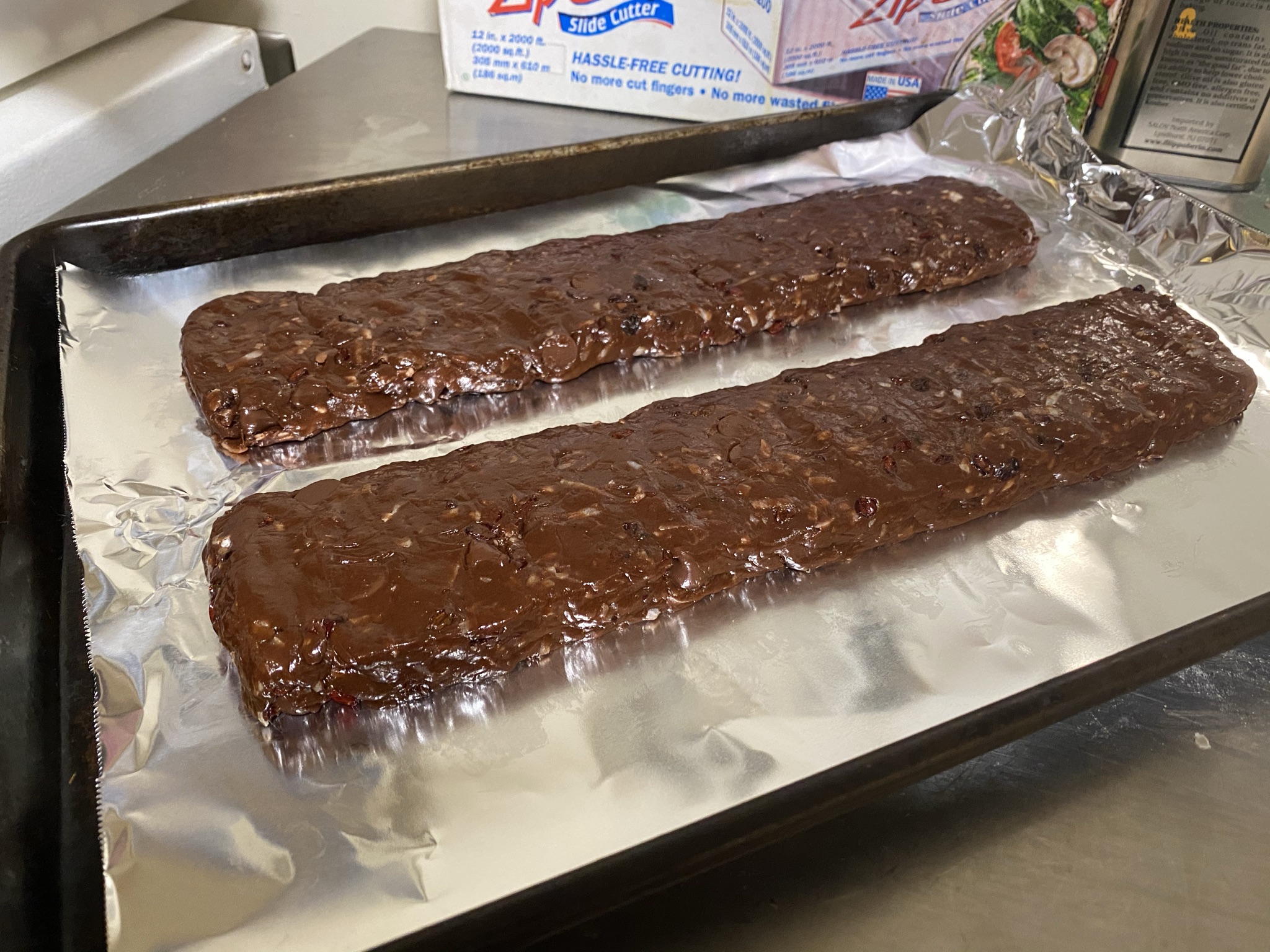 So in the course of working my way through various cookie recipes I decided to try making some biscotti, I mean what the heck, it’s a cookie, how hard can this be? So in my browsing for interesting biscotti recipes, I came across, Cranberry Pistachio Biscotti from Allrecipes. I am not a huge fan of cranberries but figured I could sub out dried cherries or dried blueberries in it.
So in the course of working my way through various cookie recipes I decided to try making some biscotti, I mean what the heck, it’s a cookie, how hard can this be? So in my browsing for interesting biscotti recipes, I came across, Cranberry Pistachio Biscotti from Allrecipes. I am not a huge fan of cranberries but figured I could sub out dried cherries or dried blueberries in it.
This weekend I decided to try my hand at it. I did not have any of the extracts left and didn’t have pistachios, so a little recipe editing was in order, plus I’ve recently developed an unhealthy (actually very healthy) addiction to cocao (not cocoa) powder and barberries (Zereshk) and have been putting both in a lot of my baked goods. The end result was actually extraordinarily good and I definitely will be making them again. A good litmus test for my baking is my husband picking up a piece and walking into my office and saying, “what’s this?” Munch, Munch. “Their good!”
Ingredients:
- ¼ cup pure olive oil
- 2 large eggs
- 4 tea maple syrup (I added a touch more liquid than the extracts original recipe to balance out the addition of the cocao powder)
- ¾ cup sugar
- 1 ¾ all purpose flour
- 1 tea kosher salt
- 1 tea baking powder
- ½ cup organic cocao (not cocoa) powder, not an affiliate link I just happen to like this brand
- ¾ cup barberries (I think pretty much any other dried fruit could be used)
- 1 cup milk chocolate chips, white or dark chocolate could be substituted
- 1 cup sweetened shredded coconut
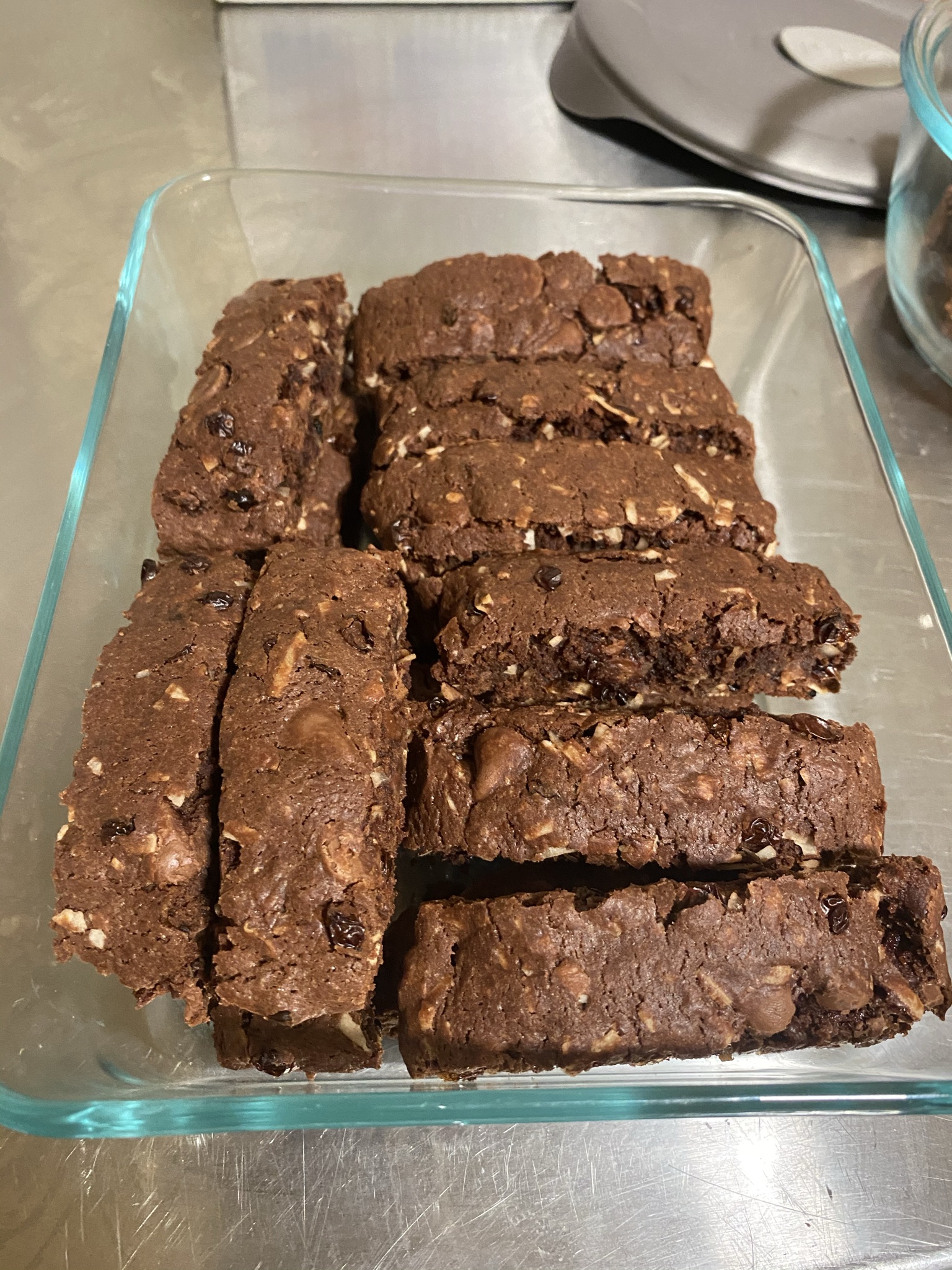 So my process for this was a bit different from Allrecipes and technically I think the ingredients have changed so much it’s not even the same or similar recipe, but I do still want to try the original, sans cranberries and wanted to credit the original source of the idea. You can use less salt if you prefer but I find most of these recipes online never actually have the amount of salt needed to make the product taste like it should. 1 tea of kosher salt for all of those ingredients is a drop in the bucket. I know everyone is sodium conscious, but I find 99% of the baking recipes out there online can be massively improved by just a small salt addition to the recipe. And for heavens sake stop using iodized salt. Yuck!
So my process for this was a bit different from Allrecipes and technically I think the ingredients have changed so much it’s not even the same or similar recipe, but I do still want to try the original, sans cranberries and wanted to credit the original source of the idea. You can use less salt if you prefer but I find most of these recipes online never actually have the amount of salt needed to make the product taste like it should. 1 tea of kosher salt for all of those ingredients is a drop in the bucket. I know everyone is sodium conscious, but I find 99% of the baking recipes out there online can be massively improved by just a small salt addition to the recipe. And for heavens sake stop using iodized salt. Yuck!
Method:
- Preheat over to 300
- Whisk together olive oil, eggs and maple syrup
- Sift together the flour, sugar, salt, baking powder and cocao powder
- Slowly incorporate the egg mixture into the flour mixture, I used both hands for this, you may want to wear gloves as it’s a bit sticky. When all of the flour mix is well incorporated, add in the chocolate chips, dried fruit (barberries in this case) and shredded coconut.
- Split mixture into two pieces and place on a baking sheet, Allrecipes called for parchment paper, I happened to be out, so tinfoil with cooking spray or a silpat mat works as well. Form the mix into to long logs, about an inch and ½ high by 12 or so inches long.
- Bake for 35 minutes. I cooled for about 5 minutes (not 10) and cut the logs into 1+ inch slices. I separated the slices out a little bit and then re-baked.
- Reduce oven to 275
- Bake for another 10 minutes, I think you can bake these for a few more minutes and they would be fine, but I like the crisp but not overly dried out results these had.
Happy Baking!
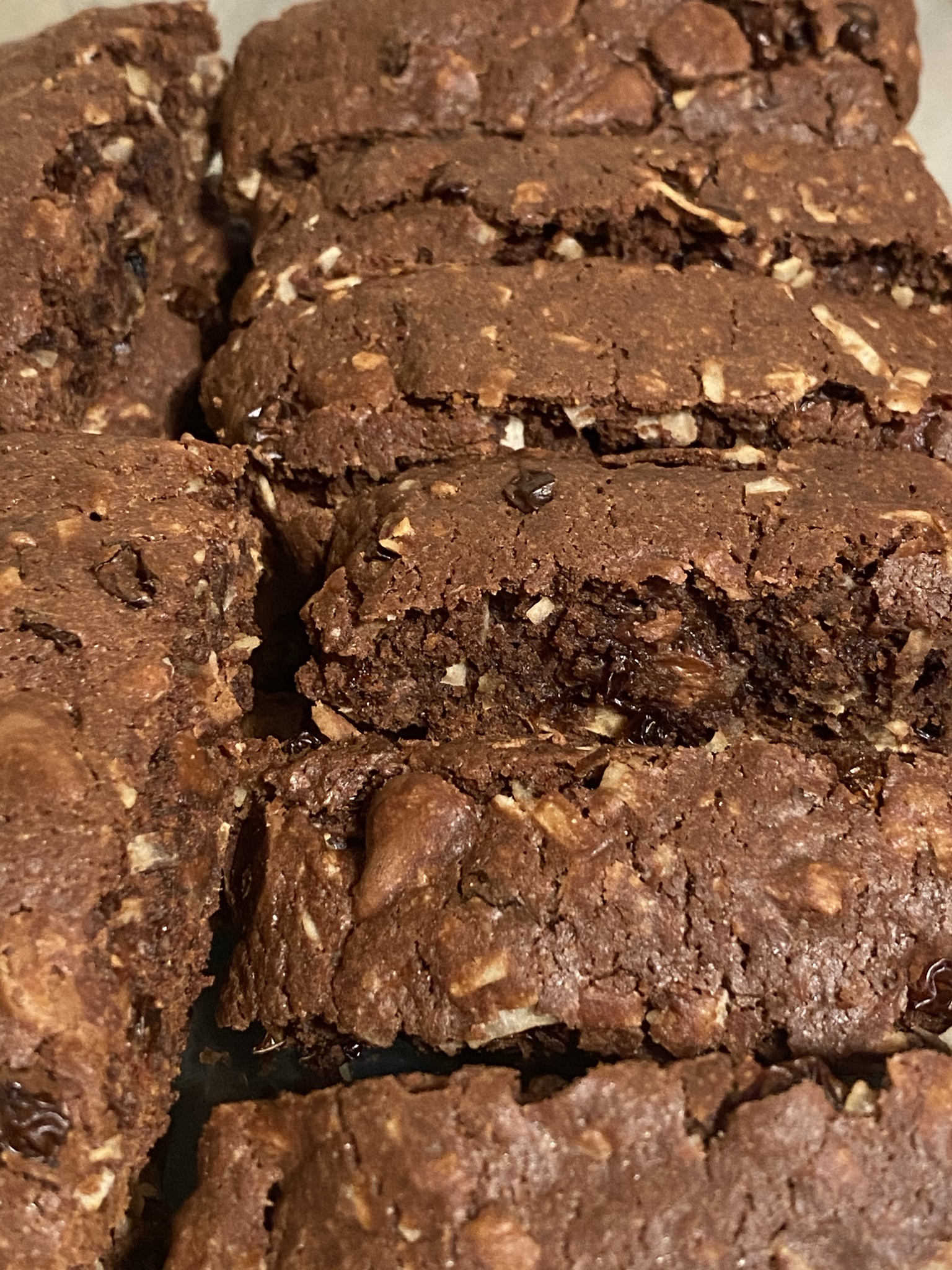
If you liked the recipe, we always appreciate a follow/like on our Facebook page (we don’t post a ton there as I personally prefer being able to chat with people but I am on FB pretty much all day during the week and your welcome to message me anytime) but would appreciate a page like and happy to reciprocate if you let us know your business page link, or you can connect on Linkedin or Twitter or just come say hello. Questions or comments about the recipe as well always happy to help with.
If you know someone that can use some social media help and would like to be able to learn it and manage it themselves (that’s what we do, we teach it) instead of paying an external company to manage it, please give me a call (860-326-0721) or email me, we are happy to help. Cheers and Happy Holidays. Please stay safe out there!
by Heather T. | Nov 25, 2020 | Blog, Food, Recipes
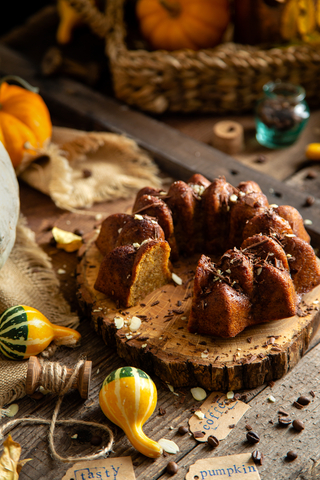 This recipe is a long treasured one, developed by master pastry chef Linde Beale at a restaurant in Kingston, NY that I worked at as one of my very first jobs in the restaurant business.
This recipe is a long treasured one, developed by master pastry chef Linde Beale at a restaurant in Kingston, NY that I worked at as one of my very first jobs in the restaurant business.
Ingredients:
1 1/2 cups good quality chocolate chips, dark chocolate is preferred but milk works as well
3 1/2 cups all purpose flour
1 1/2 tea. Double acting baking powder
3/4 lb. (1 1/2 cup) butter
1 tea. pure vanilla
1/2 tea. Mace
1 lb, plus one cup light brown sugar (3 1/4 cups firmly packed)
5 eggs
3/4 cup milk
1/4 cup bourbon
Method:
Grease and flour a Bundt pan. This recipe can also be baked in loaf pans
Sift the flour with the baking powder and set aside
With an electric mixer (paddle), cream the butter, vanilla and mace
On low speed, slowly add in the sugar and increase the speed slightly.
Incorporate the eggs one at a time into the butter sugar mix
Add in the milk and bourbon
Sift in the flour mix (this is a double sift, sifting prior and than sifting in again)
Mix until incorporated
Add in the chocolate chips and briefly mix just until incorporated.
Add batter to the pan and bake for an hour and 25 minutes at 350 or until a toothpick inserted comes out clean.
Let the baked cake sit for about 10 minutes and then remove onto a sheet pan. The glaze for this needs to be added while the cake is still warm.
Glaze
1/3 cup granulated sugar and 1/4 cup bourbon
Dissolve sugar over low heat, brush over warm cake until mix is completely gone. Let cool.
This cake can be stored for several days unrefrigerated. If you refrigerate it the consistency of it changes drastically and becomes much firmer and the bourbon flavor more pronounced. (preferred). It also freezes very well.
I love this cake served with some bourbon and honey flavored whipped cream. Snacked on at Midnight is also a favorite 🙂


 Recently there was an article on Eater. “
Recently there was an article on Eater. “
 I had a meeting with a client recently, and a big part of our conversation was about hiring for a restaurant.
I had a meeting with a client recently, and a big part of our conversation was about hiring for a restaurant. 
 So in the course of working my way through various cookie recipes I decided to try making some biscotti, I mean what the heck, it’s a cookie, how hard can this be? So in my browsing for interesting biscotti recipes, I came across,
So in the course of working my way through various cookie recipes I decided to try making some biscotti, I mean what the heck, it’s a cookie, how hard can this be? So in my browsing for interesting biscotti recipes, I came across,  So my process for this was a bit different from Allrecipes and technically I think the ingredients have changed so much it’s not even the same or similar recipe, but I do still want to try the original, sans cranberries and wanted to credit the original source of the idea. You can use less salt if you prefer but I find most of these recipes online never actually have the amount of salt needed to make the product taste like it should. 1 tea of kosher salt for all of those ingredients is a drop in the bucket. I know everyone is sodium conscious, but I find 99% of the baking recipes out there online can be massively improved by just a small salt addition to the recipe. And for heavens sake stop using iodized salt. Yuck!
So my process for this was a bit different from Allrecipes and technically I think the ingredients have changed so much it’s not even the same or similar recipe, but I do still want to try the original, sans cranberries and wanted to credit the original source of the idea. You can use less salt if you prefer but I find most of these recipes online never actually have the amount of salt needed to make the product taste like it should. 1 tea of kosher salt for all of those ingredients is a drop in the bucket. I know everyone is sodium conscious, but I find 99% of the baking recipes out there online can be massively improved by just a small salt addition to the recipe. And for heavens sake stop using iodized salt. Yuck! 
 This recipe is a long treasured one, developed by master pastry chef Linde Beale at a restaurant in Kingston, NY that I worked at as one of my very first jobs in the restaurant business.
This recipe is a long treasured one, developed by master pastry chef Linde Beale at a restaurant in Kingston, NY that I worked at as one of my very first jobs in the restaurant business.
